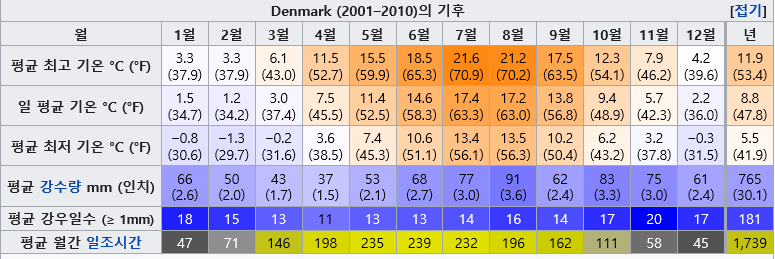Denmark Climate(덴마크 기후) |
|||||
|---|---|---|---|---|---|
| 작성자 | 안명원 | 등록일 | 21.01.12 | 조회수 | 157 |
| 첨부파일 | |||||
|
덴마크 기후는 북대서양 해류(멕시코만류)와 대서양에서으로부터 불어오는 편서풍 영향으로 겨울은 위도에 비해 온난하고, 여름은 서늘하여 연교차가 적다. 이렇게 온난한 기후는 북유럽과 중앙유럽 중간지대 특색이다. 그러나 연중 바람이 많고, 겨울은 기후 변화가 심하다. 편서풍으로 말미암아 덴마크에서 흔히 풍차를 이용하여 동력을 만들지만, 유틀란트 반도 서부는 강한 바람을 피하기 위하여 새로 개척한 농지 주변이나 독립가옥 주위에 방풍림을 조성한다. 가장 추운 1월 전국 각지 평균기온은 -1.5℃이고, 가장 더운 7월 전국 평균기온은 17℃이다. 5월부터 8월은 낮시간이 거의 18시간 지속한다. 전국 각지 연강수량은 650mm이며, 강수분포는 연간 대체로 균등하나 7∼12월, 특히 8월에 비가 많이 온다. 지역적으로는 서부가 강수량이 많고 동부로 갈수록 적어진다. 강우일수는 연간 약 160일, 강설일수는 연간 20∼40일 정도다. The climate in Denmark is warmer than latitude in winter and cooler in summer due to the influence of the North Atlantic Current (Mexico Gulf Stream) and the western wind blowing from the Atlantic Ocean. This mild climate is characteristic of the mid-region of Northern and Central Europe. However, there is a lot of wind throughout the year, and the climate changes severely in winter. Windmills are commonly used in Denmark to generate power due to the western wind, but in the western part of the Jutland peninsula, windbreak forests are built around newly opened farmland or around independent houses to avoid strong winds. The coldest January, the national average temperature is -1.5℃, and the hottest July, the national average temperature is 17℃. From May to August, the daytime lasts almost 18 hours. The annual precipitation in all parts of the country is 650mm, and the distribution of precipitation is generally uniform annually, but it rains heavily in July and December, especially in August. Regionally, the west has more precipitation, and it decreases as it goes to the east. The number of rainy days is about 160 days per year, and the number of snowfall days is about 20 to 40 days per year
|
|||||
| 이전글 | 덴마크 가수 크리스토퍼 Danish singer Christopher (김규리) |
|---|---|
| 다음글 | Danish efforts to prevent climate change |

